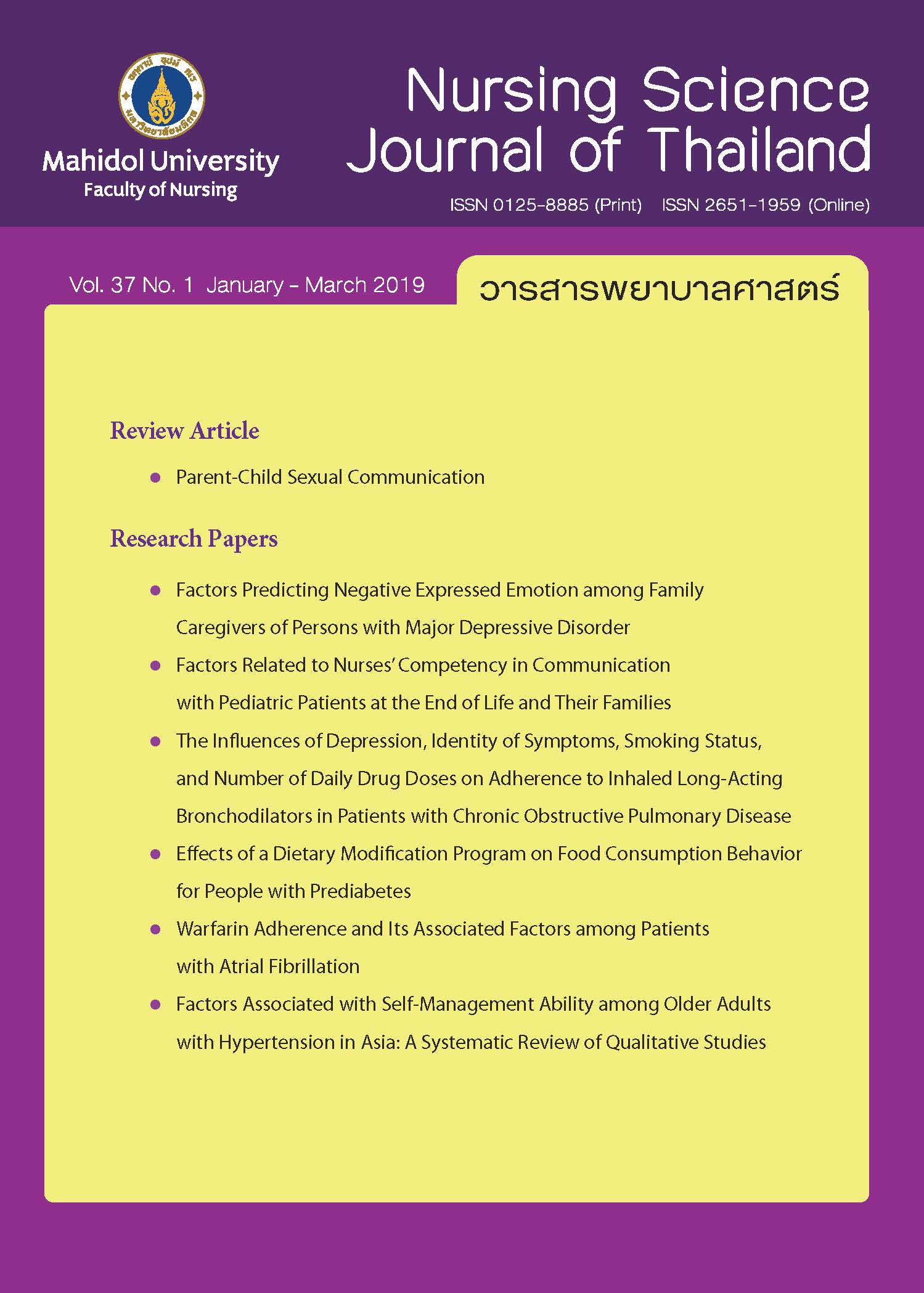Parent-Child Sexual Communication
Main Article Content
Abstract
Sexual risk behavior among Thai adolescents causes reproductive health problem that have impacted on socio-economic consequences. These problems are caused by rapid changes in both physical and psychological development during adolescence and the changes of Thai society in terms of way of life that increasingly follows Western values and culture. As a consequence, a concept of preserving abstinence of female is decreased. In addition, the advanced technology in a form of social network also causes sexual risk behaviors. However, parent-child sexual communication rarely found in Thai society because parents believe that allowing a child to learn about sex is like pointing out the way for the villain. They expect that the role of teaching sex education rather belongs to teachers. In addition, many Thai parents lack for sexual communication skills and they do not know how to start it. For this reason, the objective of this article is to present an importance of families on sexual communication with their children, core concepts of sexual communication, principles and techniques of sexual communication so that nurses who work with adolescents and families will possess basic knowledge on parent-child sexual communication and bring to their nursing practice.
Article Details
Copyright Notice: Nursing Science Journal of Thailand has exclusive rights to publish and distribute the manuscript and all contents therein. Without the journal’s permission, the dissemination of the manuscript in another journal or online, and the reproduction of the manuscript for non-educational purpose are prohibited.

Disclaimer: The opinion expressed and figures provided in this journal, NSJT, are the sole responsibility of the authors. The editorial board bears no responsibility in this regard.
References
2. Bureau of Reproductive Health, Department of Health, Ministry of Public Health. Manual for training sexual communication in family. 4th ed. Nonthaburi: Center Media and Printing Kaew Chaw Jom; 2014. (in Thai).
3. Hoyrat P, Wongsawat P. Thai adolescent with early sexual intercourse. Journal of Phrapokklao Nursing College. 2018;28(2):173-82. (in Thai).
4. Boonmongkon P, Pormnat P, Samoh N, Ojanen T, Guadamuz T, Burford J, et al. Research report on review of sexuality education in Thai schools. Bangkok: UNICEF Thailand; 2016. (in Thai).
5. Bureau of Reproductive Health, Department of Health, Ministry of Public Health. Communication about sex in Thai families [Internet]. Nonthaburi: Department of Health, Ministry of Public Health; 2014 [cited 2018 Dec 21]. Available
from: https://teenact.moph.go.th/ewt_dl_link.php?nid=29. (in Thai).
6. Siriarunrat S. Parent-adolescent daughter communication about sexuality [dissertation]. Bangkok: Mahidol University; 2009. 195 p. (in Thai).
7. Sangburan C. Parenting style and motherdaughter sexual communication on sexual behavior among early female adolescents in Bangkok [dissertation]. Bangkok: Mahidol University; 2008. 177 p. (in Thai).
8. Thampanichawat W, Olanratmanee B. Sex education for adolescents in school: a case study in Bangkok. Thai Journal of Nursing Council. 2018;33(3):82-98. (in Thai).
9. Khumsuwan K. Granma teaches mother and mother teaches children: how do children know sanctuary about sexuality? [Internet]. Nakhon Pathom: Institute for Population and Social Research, Mahidol University; 2013 [cited 2018 Dec 21]. Available from: https://www.newsletter.ipsr.mahidol.ac.th/index.php/2012-11-08-03-49-15/mnu-vol33-n06/91-vol33-no6/137-vol33-no6-issue03.html. (in Thai).
10. Peasant C, Foster RH, Russell KM, Favaro BE, Kloosky JL. Caregiver sexual and HPV communication among female survivors of childhood cancer. J Pediatr Oncol Nurs. 2016;33(3):199-208.
11. Gallegos EC, Villarruel AM, Gómez MV, Onofre DJ, Zhon Y. Research brief: sexual communication and knowledge among Mexican parents and their adolescent children. J Assoc Nurses AIDS Care. 2007;18(2):28-34.
12. Flores D. Barroso J. 21st century parent-child sex communication in the United State: a process review. J Sex Res. 2017;54(4-5):532-48.
13. Hutchinson MK. The Parent-Teen Sexual Risk Communication scale (PTSRC-III): instrument development and psychometrics. Nurs Res. 2007;56(1):1-8.
14. Hadley W, Brown LK, Lescano CM, Kell H, Spaldiney K, Diclemente R, et al. Parent-adolescent sexual communication: associations of condom use with condom discussions. AID Behav. 2009;13(5):997-1004.
15. Chareonsuk J, Phuphaibul R, Sinsuksai N, Viwatwongkasem C, Villarruel MA. Development of the causal model of young Thai female adolescents’ sexual abstinence intention. Pac Rim Int J Nurs Res Thail. 2013;17(4):329-41.
16. Hattakitpanichakul K, Phuphaibul R, Viwatwongkasem C, Phumonsakul S, The effects of the dual approach program on parent’s sexual communication and sexual abstinence intention among Thai grade 7 female adolescents. J Health Res. 2019;33(4). (in press).
17. Halstead JM, Reiss MJ. Value in sex education: from principles to practice. London: Routledge; 2003.
18. Thipsungwan K, Srisuriyawet R, Homsin P. Effects of mother-participating program on sexual communication between mother and early female adolescents. The Public Health Journal of Burapha University. 2013;8(2):69-80. (in Thai).
19. PATH Organization. Learning management of comprehensive sexuality education in schools: a guideline for school administrators. Bangkok: Urgent-tag; 2007. (in Thai).
20. Bureau of Reproductive Health, Department of Health, Ministry of Public Health. Manual…parents: prevention of teenage pregnancy. 3rd ed. Bangkok: Mahachulalongkornrajavidyalaya Printing; 2013. (in Thai).
21. Thato R, Jenkins RA, Dusitsin N. Effects of the culturally sensitive comprehensive sex education programme among Thai secondary school students. J Adv Nurs. 2008;62(4):457-69.


